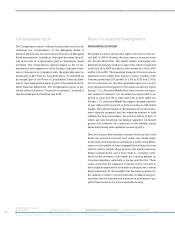Siemens 2009 Annual Report Download - page 192
Download and view the complete annual report
Please find page 192 of the 2009 Siemens annual report below. You can navigate through the pages in the report by either clicking on the pages listed below, or by using the keyword search tool below to find specific information within the annual report.
4
Reports Supervisory Board /
Managing Board Corporate Governance Management’s discussion and analysis Consolidated Financial Statements
44 Business and operating environment 63 Fiscal 2009 – Financial summary 66 Results of operations 84 Financial position
could only be available for well rated companies and at signifi-
cantly higher credit spreads as a financial crisis could lead to a
higher degree of risk awareness among investors. These de-
velopments could also influence our future possibilities of ob-
taining debt financing. Regarding our Corporate Treasury ac-
tivities, deteriorating credit quality and/or default of counter-
parties may adversely affect our results.
Further downgrades of our ratings may increase our cost of
capital and could negatively affect our businesses: Our fi-
nancial condition, results of operations and cash flows are in-
fluenced significantly by the actual and expected performance
of the Sectors and Cross-Sector Businesses, as well as the Com-
pany ’s portfolio measures. An actual or expected negative de-
velopment of our results of operations or cash flows or an in-
crease in our net debt position may result in the deterioration
of our credit rating. In June 2009, Standard & Poor’s changed
its long-term credit rating for Siemens from “AA-” to “A+”. Fur-
ther downgrades by rating agencies may increase our cost of
capital, may reduce our potential investor base and may nega-
tively affect our businesses.
Our financing activities subject us to various risks, includ-
ing credit, interest rate and foreign exchange risk: We pro-
vide our customers various forms of direct and indirect financ-
ing in connection with large projects such as those undertaken
by our Energy Sector. We finance a large number of smaller
customer orders, for example the leasing of medical equip-
ment, in part through SFS. SFS also incurs credit risk by financ-
ing third-party equipment or by taking direct or indirect partic-
ipations in financings, such as syndicated loans. We partially
take a security interest in the assets we finance or receive ad-
ditional collateral. We may lose money if the credit quality of
our customers deteriorates or if they default on their payment
obligation to us, if the value of the assets that we have taken a
security interest in or additional collateral declines, if interest
rates or foreign exchange rates fluctuate, or if the projects in
which we invest are unsuccessful. Potential adverse changes
in economic conditions could cause a further decline in the
fair market values of financial assets and customer default
rates to increase substantially and asset and collateral values
to decline, resulting in losses which could have a negative ef-
fect on our financial condition or results of operations.
Our financial condition and results of operations may be
adversely affected by several parameters influencing the
funded status of our pension benefit plans: The funded sta-
tus of our pension plans may be affected by an increase or de-
crease in the defined benefit obligation (DBO), as well as by an
increase or decrease in the value of plan assets. Pensions are
accounted for in accordance with actuarial valuations, which
rely on statistical and other factors in order to anticipate future
events. These factors include key pension plan valuation as-
sumptions such as the discount rate, expected rate of return
on plan assets, rate of future compensation increases and pen-
sion progression. Assumptions may differ from actual develop-
ments due to changing market and economic conditions,
thereby resulting in an increase or decrease in the DBO. Signifi-
cant movements in financial markets or a change in the port-
folio mix of invested assets can result in corresponding in-
creases or decreases in the value of plan assets, particularly
equity securities, or in a change of the expected rate of return
on plan assets. Also, changes in pension plan assumptions can
affect net periodic pension cost. For example, a change in dis-
count rates or in the expected return on plan assets assump-
tions may result in changes in the net periodic benefit cost in
the following financial year. In order to comply with local pen-
sion regulations in selected foreign countries we may face a
risk of increasing cash outflows to reduce an underfunding of
our pension plans in these countries, if any. The underfunding
of Siemens’ principal pension plans as of September 30, 2009
amounted to €4.0 billion, compared to an underfunding of
€2.5 billion at the end of fiscal 2008. The increase in under-
funding was primarily due to a decrease in the discount rate
assumption at September 30, 2009, which increased the DBO.
This negative effect on the funded status was only partly com-
pensated by the actual return on plan assets, which signifi-
cantly exceeded the expected return. Both factors, discount
rate and actual return, are being significantly influenced by the
conditions in the global financial markets. For additional infor-
mation, see “Notes to Consolidated Financial Statements.”
For further information with regard to financial risks and
financial risk management, see “Notes to Consolidated Finan-
cial Statements.”
























